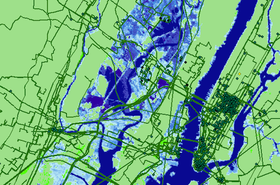The pace of change in how we produce and consume data is accelerating. As our world becomes ever more interconnected, we must adapt and plan for the needs of tomorrow – as if it were yesterday if we want to keep up. Another major change we face as a society is the shift to a world driven by renewables in the face of climate change. Mostly these shifts are considered in isolation, but a more coordinated approach reveals some useful intersections.
No time for buffering
The premise of the classic cat video is changing, where once we may have required a few milliseconds to buffer and then be on our way, the cat now requires a constant, real-time connection for us to interact with him and move through his augmented reality space. Cats in virtual reality are perhaps a fairly low priority in terms of ensuring seamless data upload and download, yet the internet of things, and emergency services, are not.
Latency – the measure of how long it takes to retrieve data from a server – is a critical issue when autonomous vehicles must make life-changing decisions instantly. It’s an important one in lots of other applications too; nobody will be interested in augmented reality if it cannot run as smoothly as real life or does not meet our visual quality requirements.
The distance between user and server is a key factor in determining the level of latency: roughly 1 millisecond is added for every 60 miles the data must travel. To reduce latency and support the changing needs of data we must bring data centers closer to their users. In the past, many data centers were located in remote areas, where real estate is cheaper, and the power grid less strained, but recent technological developments open up new opportunities to create synergies between data centers and the communities in which they serve. This brings us neatly onto district energy, heating and cooling.
Why burn a fossil fuel when we can capture energy instead?
District energy is a network of hot and cold-water pipes that can be used to heat and cool buildings, whether that be businesses, homes, universities, shopping centers etc. In more traditional set ups the thermal energy is produced by boilers, combined heat and power or absorption chillers, all of which rely on using vast amounts of energy to generate heating and cooling. Yet, waste heat is all around us, seeping out of everyday infrastructures such as sewers, electricity substations, subways, buildings and EV charging stations as well as being stored in the ground around us and water sources including rivers. So, it doesn’t make sense to expend lots of new, fossil-fuel based energy to generate heat when we could just capture it instead.
The opportunity for data centers
The process of “data” involves converting masses of electricity into massive amounts of “heat” – which the data needs to get rid of. Yet the same heat that is a nuisance for data centers can be a valuable resource for the community. By looking beyond their own doors to collaborate with the community that they serve with all of their data needs and manage their thermal load collectively, everyone stands to benefit from more affordable energy bills. For the data center it could be an additional source of revenue, and for the community it’s a reliable source of low carbon, low cost heat.
Once you’ve looked at all the economic options for capturing waste heat in your local area, geo-exchange can provide the rest. Using deep boreholes to take advantage of the consistent ambient temperature of the earth, geo-exchange can provide both heating in winter and cooling in summer. The system uses electricity as its only input and can ‘time-shift’ energy by storing or drawing excess heat from the ground on either a short-term (hour by hour) or long-term (season by season) basis. In essence it can ensure thermal loads are matched at all times, providing the same level of system flexibility as any other thermal source.
A whole-systems approach
Taking a local approach creates a different way of thinking about energy. It pushes us to take a holistic view of the system around us, not just thinking about energy, but about transport, data, infrastructure and behavior, so that we can be smarter in meeting the needs of our businesses and communities.
But taking a local approach does not mean that the benefits are only local, there are system-wide benefits too. Capturing waste heat and putting it to use reduces our consumption of fossil fuels. Creating an integrated, local grid heightens resilience, particularly against extreme weather and unplanned outages, and by being thermally efficient we can also increase energy productivity.
As our data demand grows exponentially, we must stop to think about how we power this need. The amount of data that we need to process to keep up with the evolution of the internet of things cannot also see us exponentially increase power too – particularly as we strive to meet carbon and climate targets. So how can a data center operator squeeze more out of the energy that they use? How can we process more kilobytes per kilowatt hour? The likes of Facebook and Amazon are already committing to power purchase agreements for renewable electricity, but the next move needs to be valuing waste heat properly. It’s a resource that can be recaptured and reused several times over and help to significantly improve energy productivity.
After big weather events we often see reports of energy infrastructure being damaged and becoming unavailable, or running at a reduced capacity. Whereas keeping heat or cooling in the ground is virtually impossible to destroy, and with much of the infrastructure below ground, it is a lower risk of damage. And in terms of disaster response, emergency responders increasingly depend on the data network - having critical infrastructure at full service, whether that be hospitals, fire and police stations or the data network for those responders to coordinate across, is lifesaving stuff. While many of these facilities will have backup generators for power, thermal provision is often overlooked. In a hospital where controlling the environment is critically important, a reliable, resilient system is key.
So, as we step into this new world of augmented reality and the Internet of Things, it’s important we take a moment to explore the new opportunities that this creates. And as urbanization continues it will be especially important for those cities that are already struggling to meet the needs of their inhabitants. If we encourage everyone to share energy in this way, use can be optimized – meaning less resources required all round.





